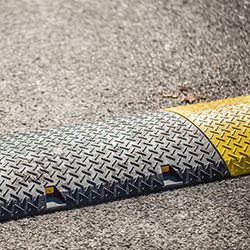Imagine driving through the hustle and bustle of city life, and you encounter a series of humps on the road. You then realize they are not just any humps, but speed humps, a common sight on Australian roads. These traffic calming measures play a pivotal role in enhancing road safety. Yet, how many of us truly understand these everyday devices?
From the humble speed hump to the more complex chicane, these measures are more than just obstacles on our daily commute. They are a testament to human ingenuity, designed to save lives on the road. This article aims to shed light on the origins, types, and importance of these little-known heroes of road safety. So buckle up, and prepare for a journey through the history and significance of speed humps and other traffic calming measures in Australia.
The History of Traffic Calming Measures
Unveiling the curtain of time, the origin of traffic calming measures like speed humps and bumps can be traced back to the mid-20th century. Originally introduced in the UK and the Netherlands, these thrifty road inventions were meant to protect the most vulnerable road users – pedestrians and cyclists. Over the decades, these measures have undergone significant transformations, adapting to the changing dynamics of road traffic and safety needs. For instance, the initial rubbery prototype of speed bumps has evolved into today’s more effective, vehicle-friendly designs. Moreover, the global traffic landscape now enjoys a diverse portfolio of these measures, each one catering to the unique road conditions of its respective country. Indeed, the journey of traffic calming measures has been as dynamic and impactful as the ceaseless wheels on the road. Their inception, evolution, and diversification stand as testament to mankind’s tireless pursuit of road safety.Why Speed Humps and Other Measures are Necessary
Speeding, the habitual nemesis of road safety, continues to pose a significant threat to drivers, pedestrians, and communities alike. The necessity of speed humps and other traffic calming measures cannot be overstated in this context. They serve a vital role in reigning in this rampant disregard for speed limits, acting as the silent custodians of road safety. These devices, akin to sleeping policemen, impose a physical constraint on speed, compelling drivers to think twice before succumbing to the allure of speed. Their effectiveness is not an anecdotal theory but a fact supported by statistics and concrete examples. Numerous accidents have been mitigated thanks to their presence, illustrating the very real, life-saving effects of these measures. Therefore, it’s crucial that we not only understand their importance but also champion their implementation as a means to foster a safer driving environment.Types of Traffic Calming Measures
With the escalating need for road safety, a variety of traffic calming measures have surfaced over the years to mitigate speeding. Each device carries its own unique purpose and effectiveness in reducing speed.- Speed Humps: These are prevalent speed reducers, designed as rounded elevations across the road.
- Speed Bumps: Compared to humps, these are more aggressive and shorter, causing a more noticeable slowing effect.
- Chicanes: These artificial narrowing built into the streets coerce drivers into changing direction, thus reducing speed.
- Roundabouts: These circular junctions compel drivers to slow down and give way to vehicles from the right.
Implementation and Maintenance of Traffic Calming Measures
Bringing traffic calming measures to life isn’t a hasty endeavor. It’s akin to cooking up a complex dish – there are several steps to follow, each demanding careful consideration. We could break it down into three critical phases, each as essential as the other to ensure a smooth, accident-free journey for all road users.-
- Planning: Much like any crucial project, implementing traffic calming measures calls for a systematic approach. From assessing the need for traffic calming measures to identifying the most suitable type, planning lays the groundwork for success.
- Consultation: It’s not a one-man show. Local communities, city planners, and road users have a seat at this discussion table. Their insights and suggestions are golden nuggets, helping to refine the blueprint.
- Installation: Deploying the chosen measures in strategic locations is the final step of this process. Professionals meticulously install speed humps, chicanes, or whichever device is chosen to ensure optimal effectiveness.

